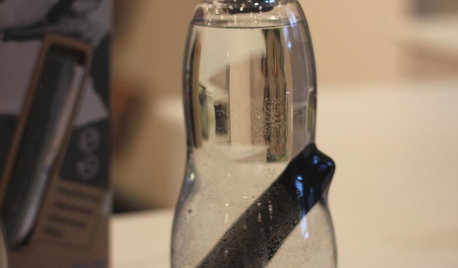Water filter, reading report
kksmama
10 years ago
Related Stories

GARDENING AND LANDSCAPINGPatio Details: Sliding Fabric Panels Filter the Light Just Right
Stepping up to the harsh sun and heat of the desert Southwest, this intimate patio is an exotic escape right outside
Full Story
TASTEMAKERSICFF 2012 Report: Black+Blum for Home Plus Office
Everyday items for the home and workplace — a water bottle, a dish rack — get an unconventional rethink by the award-winning British company
Full Story0

HEALTHY HOMEHow to Choose a Home Water Filtering System
Learn which water purification method is best for your house, from pitchers to whole-house setups
Full Story
PETSDoghouses Worth a Wag: Report From Barkitecture 2011
Annual fundraiser sniffs out the best — and quirkiest — in Austin doghouse design
Full Story
BATHROOM DESIGNDreaming of a Spa Tub at Home? Read This Pro Advice First
Before you float away on visions of jets and bubbles and the steamiest water around, consider these very real spa tub issues
Full Story
GARDENING GUIDESMake Sure You Read This Before Buying New Plants
Follow these 10 plant-selection tips to avoid buyer’s remorse
Full Story
PATTERN12 Great Decorative Alternatives to Curtains
Filter light and views while drawing the eye by dressing windows in specialty glass, artistic screens or snazzy shades
Full Story
GREEN BUILDINGWater Sense for Big Savings
Keep dollars in your pocket and preserve a precious resource with these easy DIY strategies
Full Story
HOME INNOVATIONSConsidering Renting to Vacationers? Read This First
More people are redesigning their homes for the short-term-rental boom. Here are 3 examples — and what to consider before joining in
Full Story
LANDSCAPE DESIGNGood Read: ‘Landscaping Ideas That Work’
Get a landscape architect’s strategies — along with gorgeous, inspiring photos — for a yard you’ll really enjoy
Full Story





kaseki
jadeite
Related Professionals
Hammond Kitchen & Bathroom Designers · Montrose Kitchen & Bathroom Designers · South Farmingdale Kitchen & Bathroom Designers · Normal Kitchen & Bathroom Remodelers · Centerville Kitchen & Bathroom Remodelers · Kettering Kitchen & Bathroom Remodelers · Olney Kitchen & Bathroom Remodelers · Spanish Springs Kitchen & Bathroom Remodelers · Terrell Kitchen & Bathroom Remodelers · Toledo Kitchen & Bathroom Remodelers · Tuckahoe Kitchen & Bathroom Remodelers · Joppatowne Kitchen & Bathroom Remodelers · East Moline Cabinets & Cabinetry · Forest Hills Cabinets & Cabinetry · Land O Lakes Cabinets & CabinetrykksmamaOriginal Author
MichaelsAd
kaseki
kksmamaOriginal Author
kaseki
kksmamaOriginal Author
baltomom_gw
kaseki